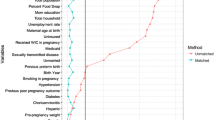Abstract
Early childhood home visiting (HV) services are expanding broadly across the United States. Supported by federal policy, HV is now an integral part of maternal and child health services. However, no nationally representative estimate of HV use is available and no research has compared HV use across states. The 2011/12 National Survey on Children’s Health was used to estimate the national and state prevalence of HV use for children 0–3 years. Generalized linear mixed modeling was used to predict HV use. An estimated 2,137,044 US children and families received HV during pregnancy and up to child age of 3 years. State HV prevalence range was 3.7–30.6 %. Nationally, 19.1 % of children below the federal poverty line received HV services. Although family poverty increased the odds of receiving HV services, higher rates of child poverty at the state level predicted less use of HV services. Important predictors of HV use include infant/child need factors (health risk, adverse experiences), predisposing factors (family size), and enabling factors (insurance type). This study provides the first estimates of national and state HV service use. Although findings indicate HV services are targeted to children at elevated risk for poor physical or developmental outcomes, our estimates show the vast majority of at-risk children did not receive HV services, including more than 80 % of low-income children, 76 % of preterm infants, and 57 % of very low birth weight infants. Increasing HV service availability could decrease negative health outcomes for young children.

Similar content being viewed by others
References
Gomby, D. S., Culross, P. L., & Behrman, R. E. (1999). Home visiting: Recent program evaluations—Analysis and recommendations. Future of Children, 9(1), 4–26. doi:10.2307/1602719.
Haskins, R., Paxson, C., & Brooks-Gunn, J. (2009). Social science rising: A tale of evidence shaping public policy (policy brief 1). Future of Children, 19(2), 1–6.
Administration for Children and Families. (n.d.). Home visiting evidence of effectiveness. US Department of Health and Human Services. Retrieved from http://homvee.acf.hhs.gov/. Accessed 2014.
Wasik, B. H. (1993). Staffing issues for home visiting programs. Future of Children, 3(3), 140–157.
Avellar, S. A., & Supplee, L. H. (2013). Effectiveness of home visiting in improving child health and reducing child maltreatment. Pediatrics, 132, S90–S99. doi:10.1542/peds.2013-1021G.
Adirim, T., & Supplee, L. H. (2013). Overview of the federal home visiting program. Pediatrics, 132, S59–S64. doi:10.1542/peds.2013-1021C.
Dodge, K. A., Goodman, W. B., Murphy, R., O’Donnell, K., & Sato, J. (2013). Toward population impact from home visiting. Zero to Three, 33(3), 17–23.
Gomby, D. S., Larson, C. S., Lewit, E. M., & Behrman, R. E. (1993). Home visiting: Analysis and recommendations. Future of Children, 3(3), 6–22. doi:10.2307/1602540.
Gomby, D. S. (2005). Home visitation in 2005: Outcomes for children and parents (Working paper No. 7). Washington DC: Committee for Economic Development, Invest in Kids Working Group.
Donelan-McCall, N., Eckenrode, J., & Olds, D. L. (2009). Home visiting for the prevention of child maltreatment: Lessons learned during the past 20 years. Pediatric Clinics of North America, 56(2), 389–403. doi:10.1016/j.pcl.2009.01.002.
Krugman, R. D. (1993). Universal home visiting: A recommendation from the US Advisory Board on Child Abuse and Neglect. Future of Children, 3(3), 184–191. doi:10.2307/1602550.
Issel, L. M., Slaughter, J. C., & Forrestal, S. G. (2011). Prenatal case management of pregnant women: What is the evidence for its contribution to a reduction of disparities in perinatal outcomes? In A. Handler, J. Kennelly, & N. Peacock (Eds.), Reducing racial/ethnic disparities in reproductive and perinatal outcomes: The evidence from population-based interventions (pp. 209–238). New York, NY: Springer.
Andersen, R. M. (1995). Revisiting the behavioral model and access to medical care: Does it matter? Journal of Health and Social Behavior, 36(1), 1–10. doi:10.2307/2137284.
National Survey of Children’s Health-2011–2012, Child and Adolescent Health Measurement Initiative. (2013). 2011–2012 NSCH: Child health indicator and subgroups SAS codebook, version 1.0. Retrieved from www.childhealthdata.org.
National Center for Children in Poverty. (2014). 50-State demographics wizard [Data table]. Columbia University Mailman School of Public Health. Retrieved from http://www.nccp.org/tools/demographics/.
SAS Institute, Inc. (2012). SAS 9.3 for relational databases [Software] (2nd ed.). Cary, NC: Author.
Environmental Systems Research Institute. (2011). ArcGIS desktop: Release 10 [Software]. Redlands, CA: Author.
Johnson, K. (2009). State-based home visiting: Strengthening programs through state leadership. National Center for Children in Poverty. Retrieved from http://www.nccp.org/publications/pdf/text_862.pdf.
Bradley, R. H., & Corwyn, R. F. (2002). Socioeconomic status and child development. Annual Review of Psychology, 53, 371–399. doi:10.1146/annurev.psych.53.100901.135233.
Duncan, G. J., & Brooks-Gunn, J. (2000). Family poverty, welfare reform, and child development. Child Development, 71(1), 188–196. doi:10.1111/1467-8624.00133.
Anda, R. F., Croft, J. B., Felitti, V. J., Nordenberg, D., Giles, W. H., Williamson, D. F., et al. (1999). Adverse childhood experiences and smoking during adolescence and adulthood. Journal of the American Medical Association, 282(17), 1652–1658. doi:10.1001/jama.282.17.1652.
Chapman, D. P., Whitfield, C. L., Felitti, V. J., Dube, S. R., Edwards, V. J., & Anda, R. F. (2004). Adverse childhood experiences and the risk of depressive disorders in adulthood. Journal of Affective Disorders, 82(2), 217–225. doi:10.1001/jama.282.17.1652.
Hack, M., Klein, N. K., & Taylor, H. G. (1995). Long-term developmental outcomes of low birth weight infants. Future of Children, 5(1), 176–196. doi:10.2307/1602514.
Olds, D. L., Hill, P. L., O’Brien, R., Racine, D., & Moritz, P. (2003). Taking preventive intervention to scale: The nurse-family partnership. Cognitive and Behavioral Practice, 10, 278–290. doi:10.1016/S1077-7229(03)80046-9.
Lanier, P., & Jonson-Reid, M. (2014). Comparing primiparous and multiparous mothers in a nurse home visiting prevention program. Birth. Advanced online publication. doi:10.1111/birt.12120.
Author information
Authors and Affiliations
Corresponding author
Rights and permissions
About this article
Cite this article
Lanier, P., Maguire-Jack, K. & Welch, H. A Nationally Representative Study of Early Childhood Home Visiting Service Use in the United States. Matern Child Health J 19, 2147–2158 (2015). https://doi.org/10.1007/s10995-015-1727-9
Published:
Issue Date:
DOI: https://doi.org/10.1007/s10995-015-1727-9



